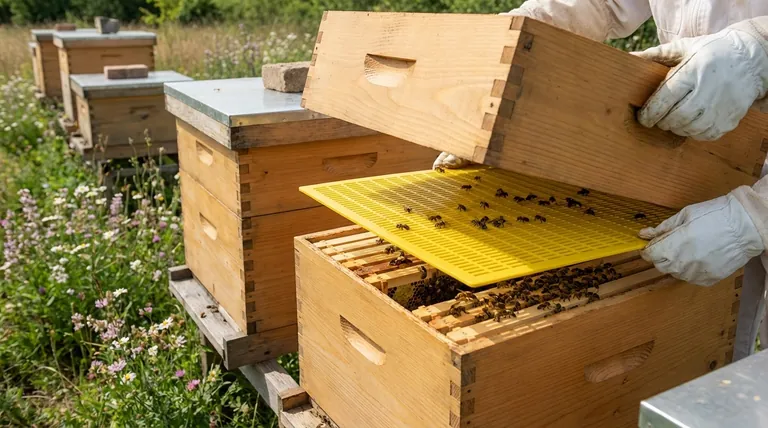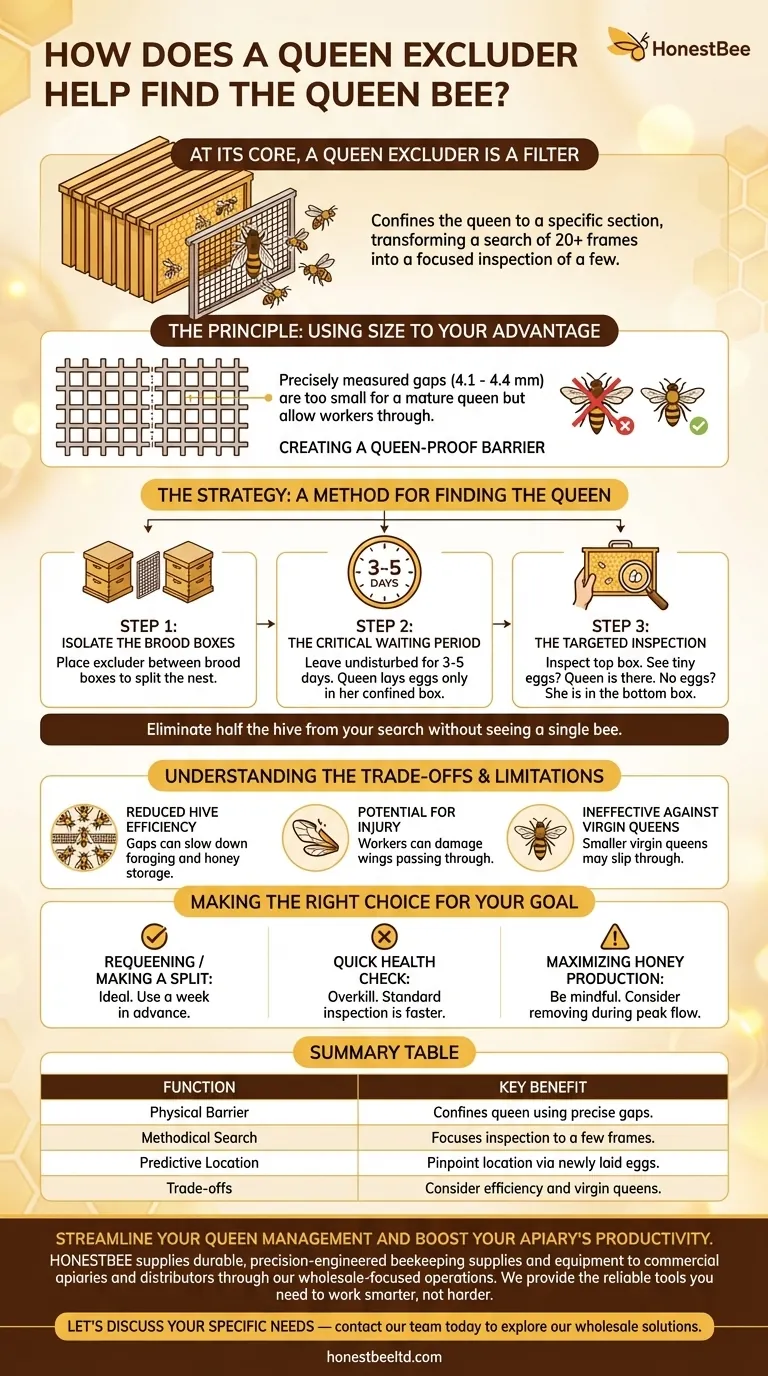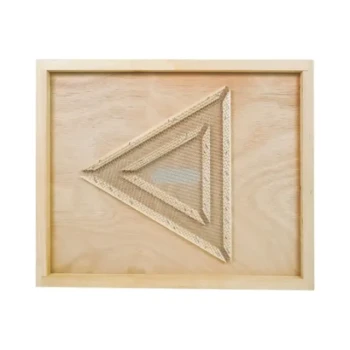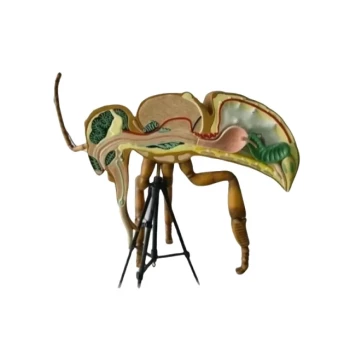At its core, a queen excluder helps you find the queen by acting as a filter. It systematically confines her to a specific section of the hive, transforming a search through ten or twenty frames into a focused inspection of just a few. By limiting her movement, you can reliably predict her location based on the presence of newly laid eggs.
The challenge isn't just seeing the queen; it's knowing where to look in a hive of 50,000 bees. A queen excluder turns this guessing game into a methodical process, using the queen's own biology against her to pinpoint her location.

The Principle: Using Size to Your Advantage
To use an excluder effectively, you must first understand the simple mechanical principle it relies on. It isn't a behavioral tool; it's a physical barrier.
How an Excluder Works
A queen excluder is a grid with precisely measured gaps, typically between 4.1 and 4.4 millimeters.
These gaps are large enough for worker bees to pass through but too small for a mature, mated queen bee and the larger male drones to fit. This simple size difference is the key to all of its functions.
Creating a Queen-Proof Barrier
By placing an excluder between hive boxes, you create a boundary the queen cannot cross. Beekeepers traditionally place it between the upper brood box and the honey supers to ensure the supers remain free of brood.
However, this same principle can be used to isolate the queen for the express purpose of finding her.
The Strategy: A Method for Finding the Queen
Using an excluder to find the queen is a planned, multi-day process. It requires patience but is far more reliable than a brute-force search, especially in a large, multi-story hive.
Step 1: Isolate the Brood Boxes
If your hive has two brood boxes, place the queen excluder between them. At this point, you don't know which box the queen is in, and that's okay. The goal is simply to split the brood nest in two.
If you have a strong suspicion of where she is (e.g., the bottom box has more eggs and young brood), you can try to place her there intentionally. But if not, simply separating the boxes is the first step.
Step 2: The Critical Waiting Period
Leave the hive undisturbed for 3 to 5 days. This is the most important part of the strategy.
During this time, the queen will continue her primary job: laying eggs. Since she is trapped in either the top or bottom brood box, she will lay eggs only in that box.
Step 3: The Targeted Inspection
After waiting, return to the hive for your inspection. Your task is now incredibly simple.
Pull a frame from the top brood box. If you see tiny, rice-like eggs, the queen is in that box. If you see no new eggs (only sealed brood or empty cells), she is guaranteed to be in the bottom box.
You have now eliminated half of the hive from your search without looking at a single bee. You can now focus your efforts on methodically inspecting the frames in the correct box until you find her.
Understanding the Trade-offs and Limitations
While effective, using a queen excluder is not without its downsides. An expert beekeeper understands these trade-offs to decide when the tool is appropriate.
Reduced Hive Efficiency
The gaps, while passable for worker bees, can slow them down. This "traffic jam" effect can slightly reduce the efficiency of foraging and honey storage, as bees must spend more time and energy squeezing through the grid.
Potential for Injury
In some cases, worker bees can damage their wings by repeatedly passing through the excluder. While not a major threat to the colony's survival, it is a factor to consider for overall colony health.
Ineffective Against Virgin Queens
A newly emerged, unmated queen is significantly smaller than a mature, mated queen. She can often slip through a standard excluder, making this method unreliable for finding and containing virgin queens.
Making the Right Choice for Your Goal
Deciding whether to use the excluder method depends entirely on your objective for finding the queen.
- If your primary focus is requeening or making a split: This method is ideal. Use it a week in advance to guarantee you can find and isolate the old queen with minimal stress and hive disruption.
- If your primary focus is a quick health check: This strategy is likely overkill. A standard frame-by-frame inspection is faster if your goal is just to spot-check her laying pattern in a smaller colony.
- If your primary focus is maximizing honey production: Be mindful of the excluder's impact. Use it to find the queen when necessary, but consider removing it during peak honey flow to ensure maximum foraging efficiency.
Ultimately, the queen excluder is a powerful tool for hive management when used with clear intention and purpose.
Summary Table:
| Function | Key Benefit |
|---|---|
| Physical Barrier | Confines the queen to a specific brood box using precise gap sizes (4.1-4.4mm). |
| Methodical Search | Transforms a search of 20+ frames into a focused inspection of just a few. |
| Predictive Location | Pinpoint the queen's location by identifying newly laid eggs after a 3-5 day waiting period. |
| Trade-offs | Can slightly reduce hive efficiency and is ineffective for containing smaller virgin queens. |
Streamline your queen management and boost your apiary's productivity.
As a commercial beekeeper, your time is valuable. The strategic use of a high-quality queen excluder is just one part of effective hive management. HONESTBEE supplies durable, precision-engineered beekeeping supplies and equipment to commercial apiaries and distributors through our wholesale-focused operations.
We provide the reliable tools you need to work smarter, not harder. Let's discuss your specific needs — contact our team today to explore our wholesale solutions.
Visual Guide

Related Products
- Professional Plastic Queen Excluder for Modern Beekeeping
- Wooden Queen Bee Excluder for Beekeeping
- Premium Wood Framed Metal Wire Queen Bee Excluder
- High Performance Plastic Queen Excluder for Beekeeping and Apiary Management
- Metal Queen Bee Excluder for Beekeeping
People Also Ask
- What is a Queen Excluder and how does it work? Achieve Purer Honey & Better Hive Control
- How does a queen excluder work? Master Hive Management for Pure Honey Harvests
- What are the pros of using a queen excluder? Boost Hive Control & Honey Quality
- What is the purpose of a queen excluder when adding a super? Streamline Your Honey Harvest
- What are the main advantages of using a queen excluder in beekeeping? Simplify Hive Management & Harvest



















